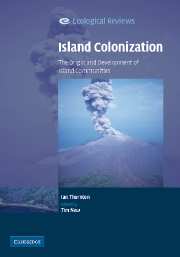Book contents
- Frontmatter
- Contents
- Editorial preface
- Acknowledgements
- PART I Theoretical and experimental studies
- PART II Natural recolonization after devastation
- PART III The recolonization of devastated islands
- 5 Recovering island biotas: Volcano and Bárcena
- 6 Thera, Santorini Group, Mediterranean
- 7 Long and Ritter Islands, Bismarck Sea
- 8 Krakatau, Sunda Strait
- PART IV Assembly of biotas on new islands
- PART V Colonization and assembly
- References
- Index
5 - Recovering island biotas: Volcano and Bárcena
Published online by Cambridge University Press: 12 January 2010
- Frontmatter
- Contents
- Editorial preface
- Acknowledgements
- PART I Theoretical and experimental studies
- PART II Natural recolonization after devastation
- PART III The recolonization of devastated islands
- 5 Recovering island biotas: Volcano and Bárcena
- 6 Thera, Santorini Group, Mediterranean
- 7 Long and Ritter Islands, Bismarck Sea
- 8 Krakatau, Sunda Strait
- PART IV Assembly of biotas on new islands
- PART V Colonization and assembly
- References
- Index
Summary
In most recorded cases of the recovery of island biotas after natural extirpation, the earliest stages of recovery have not been monitored. In most instances there was no biotic survey of the island before the devastating event brought it to biologists' attention, often, although not always, because the event occurred so long ago. Thus the pre-devastation biota is usually unknown, or at least not known precisely. Sometimes, however, insight can be gained by assuming that the biota of the island before extirpation was similar to biotas now present on unaffected islands in the same region, if such ‘control’ islands exist. A comparison between these and the existing, reassembled biota of the affected island provides a fairly rough-and-ready estimate of the extent of recovery.
Another problem besetting such studies is that destruction of the previous community was often incomplete and the extent of destruction often only imprecisely known, so that the base from which recovery proceeded can only be guessed. One such case is Volcano Island in the Philippines.
Volcano Island, Lake Taal, Philippines, 1911
Taal Volcano, on the island of Luzon in the Philippine Archipelago, some 50 km south of Manila, is a low volcanic cone with a 21 by 13 km young prehistoric caldera complex – Lake Taal or Lake Bombon (about 300 km2) (Fig. 5.1). Within the caldera lake lies an island, Volcano Island, which has an area of 25 km2 and itself has a small crater lake.
- Type
- Chapter
- Information
- Island ColonizationThe Origin and Development of Island Communities, pp. 61 - 71Publisher: Cambridge University PressPrint publication year: 2007



